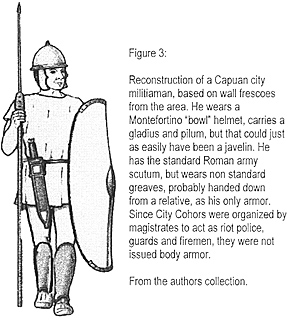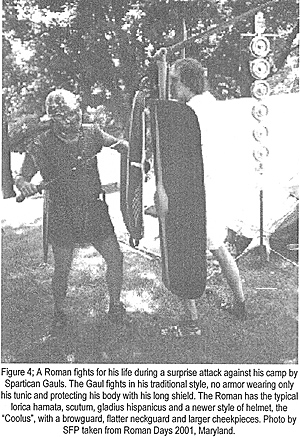 Numbers
Numbers
It is important to understand that veteran legiones of Sulla's wars were out of Italy, fighting in Spain against Sertorius' rebellion, while other veteran legiones were in Asia Minor fighting against Pontus. While the bulk of the vets were out of the country, Rome was secure in the knowledge they had the manpower for at least eight-ten more. However, this was on paper, since the time Gaius Marius had abolished the property qualification and threw recruitment open to the head count, solders had joined for pillage to gain wealth. There would be little wealth in servile war. Therefore the solders had to be impressed into the legiones.
Figure 3: Reconstruction of a Capuan city militiaman, based on wall frescoes from the area. He wears a Montefortino "bowl" helmet, carries a gladius and pilum, but that could just as easily have been a javelin, He has the standard Roman army scutum, but wears non standard greaves, probably handed down from a relative, as his only armor. Since City Cohors were organized by magistrates to act as riot police, guards and firemen, they were not issued body armor. From the authors collection.
This is not the way to gain crack fighting men. The old vets 40-50 years in age, from the Pontic or Sullan wars wouldn't leave their farms until the danger was great or it would be profitable. And that wasn't until Crassus took over command and offered financial incentive to join the Eagles. So there was a manpower vacuum even though the Senate did not see it as such.
Next the Senate underestimated Spartacus, treating him like a brigand, until he had a taste of success. Then they panicked, ordering Cn. Cornelius Lentulus to engage, before his four legiones consular army was ready. Cnius Cornelius was a veteran general who had fought with L. Cornelius Sulla, during the Social War, and he did the sensible thing. Knowing his troops' limitations he attempted to build fortifications to hinder Spartacus. That he was attacked, his officers captured, his army routed, was not his fault and is proof that Spartacus was an able tactician. By the time of Mummius'defeat, the high tide of the war had passed, and the doom of the revolt was assured.
The Senate had decided that the threat to the country was high, so they had developed a three prong assault with three armies. Had Spartacus routed Crassus, he was trapped between Pornpeius in the North, and Lucullus in the South. And it was doubtful that he could destroy Crassus, the best he could hope for was to push him out of the way, but Crassus would still exist, and could hound him until Pompeius could join.
Roman numbers revolve around two legiones (10,000) in most of the campaigns until the end. Veteran armies came into existence as the levies hardened into regular solders. Cn. Cornelius Lentulus consular army was four full strength green legiones, (20,000) as was Lucius Gellius Publicola's consular army. He defeated Crixus' Germans of similar numbers so it may have had better training. Two broke and ran later under Mummius, but we are not certain of the circumstances. Crassus had six legiones though two had been badly cut up, and Pompeius had four or five though not full strength. Marcus Lucullus may have had two full strength ones or three weak ones.
There is no mention of any cavalry or auxiliaries in the armies. It is not till Crassus requests the Equities (knights) to join him, promising glory, do we have any reports of Roman heavy horse. They help win the final battle against Castus and Cannicus.
Slave numbers: When we look at a number as Appius' 120,000 what are we to think? Does this mean there were 120,000 fighting men available to Spartacus? This is doubtful, if we take Delbruck's rule of thumb, that large numbers were the tribe's total population, and 20 percent the tribe were of fighting age, 10% adolescents, so 120,000 would translate to 36,000 true fighting men, with another 10,000 that could be used if necessary. As the slaves joined they would have brought their families, who would be a minimum of three members, maybe more.
If we assume the original revolting gladiators were 200 strong with no families (Appius) and every third person that joined the revolt brought two additional family, with an average of ten men of fighting age joining per day, we end up with nineteen people joining the revolt per day. At the end of seven days, instead of 70 new men, you have 133 new members, 70 which are of fighting age. And the two additional family members is a conservative estimate, likely the average taken from the plantations and towns were many more.
When Spartacus won against the first three Practors he had the element of surprise, against the other Praetors in the next two fights, he had numbers. As he fortunes declined, he lost men. Crixus left with 30-20,000 Germans (presumably most of these would be fighters) there was 30,000 lost to straggling, likely non combatants, perhaps 60,000 abandoned in Bruttium. Under Castus and Cannicus 12000 lost in combat, 25,000 lost at the final battle, 5-10,000 escaped, 6,000 captured.
The 60,000 should be considered non-combatants since Spartacus only took fighting men in his breakout. They are no longer mentioned in any narrative. Presumably they were walled up in the Scyllaeum isthmus at the toe of the boot and left to starve. They would be put to death at any rate for their pail in the slave revolt.
Armor and Dress
Many companies sell figures they call Spartacan having gladiator style helmets, manicas, greaves. (fig 2) These are a fiction, Appius tell us that "they first had knives and clubs," (13C. I 116.) Plutarch tells us "First then routing those that came out of Caupa against them, and thus procuring a quantity of proper solders' arms, they gladly threw theirs away as barbarous and dishonorable (Life of Crassus). The solders who routed must have been the city cohortes of Capua. These would be militia, but still have Roman oval scutums and bowl helmets armed with short sword and pilum orjavelin (see fig. 3).
It was from these, that his followers first received his arms. After routing the 3000 at Vesuvius, Spartacus had true defensive armor, chain mail, (lorica hamata) and his selected gladiators and field slaves much have looked more Roman than barbarian (as in fig. 1).
How many of these would look Roman? Obviously not every slave would receive a lorica hamata Florus tells us "they made themselves rude shields of wickerwork and the skins of animals..."
So the bulk of the army would be an unarmored horde. Most of the slaves were Gauls and Germans, with some from Asia Minor. Plutarch tells us as well "shepherds and herdsmen that were there (near Naples) stout and nimble fellows revolted over to them, to some of these they (the gladiators) gave complete arms, (I.E. heavy arms) and made use of others as scouts and light armed solders" (Life of Crassus). Plutarch also mentions that Spartacus had cavalry, which he used with his Thracians. That would tend to indicate the cavalry was lightly armed and used for scouting.
Cavalry was raised by "grabbing horses from the farms, and having Spartacus' kinsmen ride." Perhaps it would be safe to guess at least one third of Spartacan forces could be armored at any one time. If that seems high at least 1/4, based on the Roman defeats and the slaughter of the troops, would be certain.
 Figure 4; A Roman fights for his life during a surprise attack against his camp by Spartican Gauls. The Gaul fights in his traditional style, no armor wearing only his tunic and protecting his body with his long shield. The Roman has the typical lorica hamata, scutum, gladius hispanicus and a newer style of helmet, the "Coolus", with a browguard, flatter neckguard and larger cheekpieces. Photo by SFP taken from Roman Days 2001, Maryland.
Figure 4; A Roman fights for his life during a surprise attack against his camp by Spartican Gauls. The Gaul fights in his traditional style, no armor wearing only his tunic and protecting his body with his long shield. The Roman has the typical lorica hamata, scutum, gladius hispanicus and a newer style of helmet, the "Coolus", with a browguard, flatter neckguard and larger cheekpieces. Photo by SFP taken from Roman Days 2001, Maryland.
Fighting Styles
While the Roman army sometimes used gladiators to train recruits, the two systems were completely different. Question is how many gladiators were in Spartacus army?
We don't know the final number, but perhaps 5000 would be close.
Gladiators fought Samnite style during this period, so they would be swordsmen, with good fencing skills, but no ability to work in unison or carry out battlefield relief Since they were used to dodging, and moving, while fighting, loose order was probably the likely formation they would be comfortable in. The German and Gaulic slaves would recall their martial practice by forming traditional war bands, 1000 strong, the Gauls fighting in a looser formation then the Germans, but still closer then gladiators. Since the Gauls had to use short swords, they did not need to be spaced out so far as to be able to swing their longer Gaulic swords. (See Fig.4)
Traditionally, Gauls disliked Germans but some accommodation must have been made for them to fight side by side. Greek, Spanish shepherds and herdsmen became the light armed, perhaps there were some Greeks who could use the sling, it was the traditional weapon of the herdsman, but the numbers would be very slight. Most, if not all, were probably javelin men.
The Romans
Romans made do with the legio since they were in Italy, the Equites were called out but only towards the end of the campaign. The Velites (light armed) had been discontinued. The cohors 500 strong, eight to ten ranks deep was the building block, but the Legio was the weapon, fighting in two or three lines. Since the Romans usually were outnumbered the later was more possible. Romans were well equipped, protected and fought in close formation 3' apart to use their swords. After 15 min. the front line would exchange and fresh men would be fighting an exhausted enemy, usually giving victory to the Romans. This took training and discipline, something that took at least a month often longer to achieve.
Spartacus never gave Roman armies that much time to train. The result? He defeated them.
More The War against Spartacus L. Anneus Florus "Epitome of Roman History" Book II. VIII. Bellum Spartacium
Back to Strategikon Vol. 1 No. 4 Table of Contents
Back to Strategikon List of Issues
Back to MagWeb Master Magazine List
© Copyright 2001 by NMPI
This article appears in MagWeb (Magazine Web) on the Internet World Wide Web. Other military history articles and gaming articles are available at http://www.magweb.com